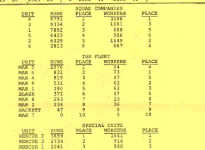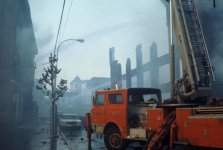- Joined
- May 6, 2010
- Messages
- 17,403
Squad Company 4 was one of two FDNY units (Ladder 19 the other) used by NASA Manned Spacecraft Center for field testing of the prototypes of their lightweight SCBA equipment.SQ*4 1970 ....10,000. RUNS....
Black panel on door states " WORLDS BUSIEST FIRE COMPANY"
TyVxvEUxOwJbZsrICcSd.png
Squad 4 did over 10,000 runs in the late 1960s. I was a fireman in Tower Ladder 18 and was going to College for Fire Science, so I was involved in the NASA "Firefighters Integrated Response Ensemble System," = Project F.I.R.E.S, along with member of Squad 4, Ladder 19 and units from Huston, Texas and I think Chicago and L.A.. The FIRES program that was a program to use technology from the NASA space program for other uses. NASAs Technical Utilization Committee ran the program. Out of it came Nomex for turnout coats, the Scott 4.5 SCBA (based on the Astronauts space breathing system) Better fire helmets, and to a certain degree some E.M.S. equipment such as defibullators. (Hope that is spelled right?) Who says the space program was a waste. Captain Bob Rainey FDNY Engine 26 retired
On Page A-1 is a letter to NASA engineer Pat McLaughlan.
During a recent podcast for members of this site a few weeks ago, Ira Hoffman the GURU of Runs and Workers was the guest speaker. About a dozen of us tuned in, saw and heard Ira clearly state that not a single FDNY company broke 10k runs, despite rumors of the officer throwing tickets away, not recording runs, blowing away from his tie clip, not reporting trash can fires, etc etc. Let's also not forget the solid dispatchers whose main responsibility is to record each and every run was a source too. Here is the R&W tally by Ira Hoffman of Sq 4 1970.Squad 4 did over 10,000 runs in the late 1960s. I was a fireman in Tower Ladder 18 and was going to College for Fire Science, so I was involved in the NASA "Firefighters Integrated Response Ensemble System," = Project F.I.R.E.S, along with member of Squad 4, Ladder 19 and units from Huston, Texas and I think Chicago and L.A.. The FIRES program that was a program to use technology from the NASA space program for other uses. NASAs Technical Utilization Committee ran the program. Out of it came Nomex for turnout coats, the Scott 4.5 SCBA (based on the Astronauts space breathing system) Better fire helmets, and to a certain degree some E.M.S. equipment such as defibullators. (Hope that is spelled right?) Who says the space program was a waste. Captain Bob Rainey FDNY Engine 26 retired

My father worked in that house in the 40’sA Look Back. What a great looking house! Yesterday and today. View attachment 41796View attachment 41797

 www.instagram.com
www.instagram.com
Looking at the runs for Marine Companies, there runs were in the East River. Marines 4, 5, 6, & 7 covered the East River, while Marine 1, & 2 were on the Hudson Rv. Marine 8 & 9 covered NY Bay. That still holds true today that the East Rv is busier..During a recent podcast for members of this site a few weeks ago, Ira Hoffman the GURU of Runs and Workers was the guest speaker. About a dozen of us tuned in, saw and heard Ira clearly state that not a single FDNY company broke 10k runs, despite rumors of the officer throwing tickets away, not recording runs, blowing away from his tie clip, not reporting trash can fires, etc etc. Let's also not forget the solid dispatchers whose main responsibility is to record each and every run was a source too. Here is the R&W tally by Ira Hoffman of Sq 4 1970.
View attachment 41794
I saw on another site where L103-Ret. Spoke of going into work at POSA (290/103-Sheffield Ave) at 6PM, and, if they were Lucky, getting back at 9ATalk to and listen to the men that worked in Brownsville, East New York, South Bronx, Harlem, etc. The running was there and the work was there. Dropped and/or lost run tickets, JTO's edicts and the CO's being overwhelmed all contributed to a scenario where we don't know what the "true numbers" are for sure, BUT one thing is for certain, the guys who worked those neighborhoods back then worked their tails off and gave us a helluva "War Years" legacy.
To those of them who are still with us - God love you and thank you for your service and dedication.
To those who aren't with us any more - Rest in Peace and thank you for what you did and the tradition we continue to honor.
 other cities, had their "War Years." A great book about "Boston's war years" is called "Busy as Hell' Both #1 & #2.
other cities, had their "War Years." A great book about "Boston's war years" is called "Busy as Hell' Both #1 & #2.